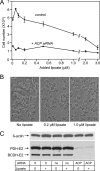Down-regulation of mitochondrial acyl carrier protein in mammalian cells compromises protein lipoylation and respiratory complex I and results in cell death
- PMID: 19221180
- PMCID: PMC2670149
- DOI: 10.1074/jbc.M806991200
Down-regulation of mitochondrial acyl carrier protein in mammalian cells compromises protein lipoylation and respiratory complex I and results in cell death
Abstract
The objective of this study was to evaluate the physiological importance of the mitochondrial fatty acid synthesis pathway in mammalian cells using the RNA interference strategy. Transfection of HEK293T cells with small interfering RNAs targeting the acyl carrier protein (ACP) component reduced ACP mRNA and protein levels by >85% within 24 h. The earliest phenotypic changes observed were a marked decrease in the proportion of post-translationally lipoylated mitochondrial proteins recognized by anti-lipoate antibodies and a reduction in their catalytic activity, and a slowing of the cell growth rate. Later effects observed included a reduction in the specific activity of respiratory complex I, lowered mitochondrial membrane potential, the development of cytoplasmic membrane blebs containing high levels of reactive oxygen species and ultimately, cell death. Supplementation of the culture medium with lipoic acid offered some protection against oxidative damage but did not reverse the protein lipoylation defect. These observations are consistent with a dual role for ACP in mammalian mitochondrial function. First, as a key component of the mitochondrial fatty acid biosynthetic pathway, ACP plays an essential role in providing the octanoyl-ACP precursor required for the protein lipoylation pathway. Second, as one of the subunits of complex I, ACP is required for the efficient functioning of the electron transport chain and maintenance of normal mitochondrial membrane potential.
Figures






References
Publication types
MeSH terms
Substances
Grants and funding
LinkOut - more resources
Full Text Sources

